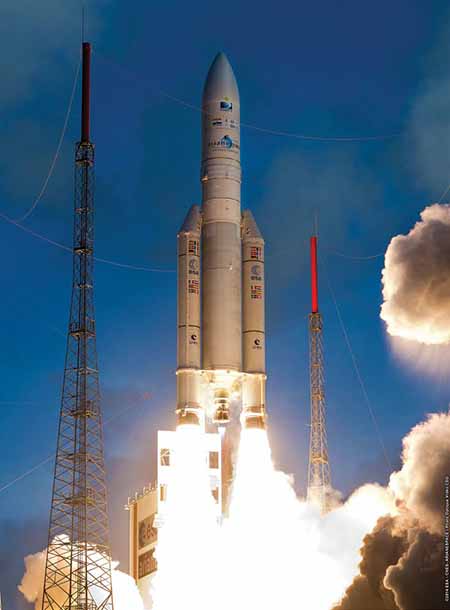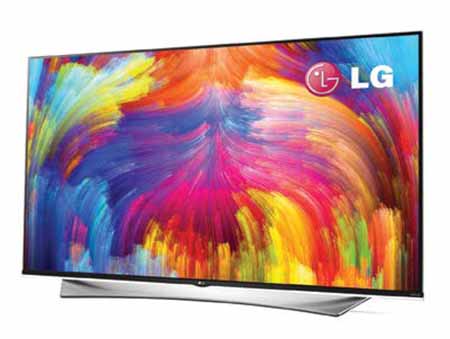Will UHD Content Take Off in 2015?

The DirecTV-14 satellite, poised to deliver UHD content to it subscribers this year, was launched by an Ariane 5 ECA launch vehicle last month.
LOS ANGELES—When DirecTV launched its DirecTV-14 satellite recently, its promise of 4K/UHD programming to its U.S. subscribers became a reality for 2015. According to DirecTV, the new satellite will be the first commercial satellite to use the “Reverse Band Direct Broadcast Satellite” spectrum, giving it the capacity to deliver ultra highdefinition video-on-demand programming across the contiguous 48 states as well as Alaska, Hawaii and Puerto Rico. DirecTV also plans to offer live 4K programming sometime in 2015, it said.
2015 is shaping up to be the year that UHD content becomes more available to larger audiences. According to a report from DisplaySearch, sales of UHD units in 2014 topped 6.4 million; 4KTV sets are expected to be prevalent at this week’s International CES with sales anticipated to be robust in 2015.
HARDWARE TAKES THE LEAD
“In every new technology introduction, the content people say they won’t develop for it unless there’s an install base, and the machine people say they won’t build unless there’s content,” says Jon Peddie, president of Jon Peddie Research in Tiburon, Calif. “For UHD displays, the hardware people have taken the lead.”
UHD content providers are jumping on board. In addition to DirecTV’s anticipated 4K VOD launch, 4K content is already or will soon be on offer from a range of providers. “In 2015, I will be able to watch 4K by streaming content from Amazon, Netflix and a handful of others,” says Richard Doherty, research director for Envisioneering in Seaford, N.Y. “Sony and Samsung have their 4K caching systems for the home. I think we’ll have many announcements going forward for streamed and downloaded UHD content.” In addition to those named by Doherty, UHD will be on tap on YouTube, Sony Unlimited Video Service, Vimeo and M-Go, the latter a Comcast 4K streaming app for Samsung-manufactured 4K displays.

Amazon Prime is streaming “Tony Bennett and Lady Gaga: Cheek to Cheek Live” in 4K to its Prime subscribers. Despite the proliferation of UHD displays and content providers, the actual catalogue of 4K programs is still thin. DirecTV will offer a handful of VOD movies, including “Transformers: Age of Extinction” and “Forrest Gump,” along with live events, which the company says will most likely consist of sports and concerts.
Netflix and Amazon have taken the strategy of creating original 4K content. Most famously, in April 2014, Netflix debuted season two of “House of Cards” in 4K. Amazon, which streams 4K to its Amazon
Get the TV Tech Newsletter
The professional video industry's #1 source for news, trends and product and tech information. Sign up below.

Jon Peddie Prime customers, is ratcheting up for the second season of its many originals, including the critically acclaimed “Transparent,” as well as “Alpha House” and the concert “Tony Bennett and Lady Gaga: Cheek to Cheek Live!” Amazon is also piloting other 4K original shows, including “Mozart in the Jungle,” “Bosch,” “Hand of God,” “The After” and “Red Oaks.”
Netflix and Amazon also rely on 4K versions of existing content, as well. Netflix has added “Breaking Bad” (which was shot in film), “The Blacklist” (shot with the Sony F55 in RAW format), and a handful of movies including “Jerry Maguire,” “Ghostbusters” and “Crouching Tiger, Hidden Dragon.” Amazon is also offering movies in 4K, some as part of the Amazon Prime offering and others for an additional fee.
Another 4K content provider, Sony Unlimited Video Service, relies on a Sony media player, but will likely offer access to Sony’s catalogue of movies and TV shows.
LG Opens Door to ‘Better Pixels’ With Quantum Dot 4KTV
SEOUL—TV as we know it doesn’t cover the same color range as the human eye, but LG Electronics is taking a step closer to display technology that covers more of it. The Korean consumer electronics giant said it will unveil a new quantum dot 4K Ultra-HD TV at this week’s International Consumer Electronics Show in Las Vegas, adding that quantum dot technology displays a “wider color palette and improved color saturation than conventional LCD TVs.”
Five out of five 3M scientists agree that quantum dot display technology renders a wider color palette, or “gamut” in engineering terms. “Quantum dot-enabled liquid crystal displays provide one alternative with potential to meet Rec. 2020’s standard color gamut while taking advantage of existing manufacturing capacity. We examined how existing QD and LCD technology could be optimized to meet the Rec. 2020 color standard. Our analysis revealed that up to 94 percent gamut coverage can be achieved,” James Thielen, James Hills, Ph.D.; John Van Derlofske, Ph.D.; Dave Lamb, Ph.D.; and Art Lathrop said in a paper presented at the Society of Motion Picture Engineers Technical Conference in Hollywood in October.
Rec. 2020 is the recommendation of the International Telecommunications Union for the broadcast standard of ultra high-definition 4KTV. Among other things, Rec. 2020 specifies a color gamut that is 150 percent of NTSC, the standard used for analog TV. The 3M team said quantum dots may be the most “practical solution” to achieving a wider color gamut in TV displays.

LG Electronics is unveiling a new 4K Ultra HD TV series with quantum dot technology as a new component of its expanded TV lineup at this week’s International CES. The rise of higher than high-definition TV has sparked a parallel exploration of expanding the traditional color gamut of the medium and its displays. “Better pixels” is the way Dolby’s Pat Griffis summarizes display technology that accommodates a wider color gamut and luminance range. This concept of better pixels is favored in general by TV and movie engineers, who question the discernibility of higher resolutions in the typical “First World” household, according to Carolyn Giardina in the “The Hollywood Reporter.”
LG says its technology works by “harnessing nano crystals” ranging in size from 2 to 10 nanometers. “Each dot emits a different color depending on its size. By adding a film of quantum dots in front of the LCD backlight, picture color reproduction rate and overall brightness are significantly improved.” The company said quantum dot film technology increased the color accuracy and “extrawide viewing angles” of its in-plane switching LCD displays by 30 percent. It said the technology also contains “no cadmium or any other toxic heavy metals.”
LG says its quantum dot 4K displays will become available later this year.
Deborah D. McAdams
YouTube has offered a 4K channel for some time, which features a surprising amount of professionally shot work, much of it wildlife or nature. “YouTube may drive 4K the most,” said Peddie. “They’ve dedicated a 4K channel so that anyone who makes 4K content—and that’s anyone who has a good smartphone—can make 4K content and post it.” Apple’s iPhone 6, Samsung Galaxy S5, Samsung Galaxy Note 3, Sony Xperia Z2, and Qualcomm’s Snapdragon 810 are among the smartphones that offer 4K video recording.
BEYOND OTT
Very little content is coming from more traditional sources of film and TV. Light Iron, a post-production house just acquired by Panavision, has specialized in finishing 4K-to-6K content, and CEO Michael Cioni says his staff has dubbed 2014 “the year of 4K.” “UHD/4K-plus now makes up more than 50 percent of Light Iron’s work,” said Cioni, who counts 10 feature films shot in resolutions ranging from 3K to 6K and “Transparent,” Amazon’s 10-episode second season series.
But, much to Cioni’s surprise, very little of it is coming from movie studios. “Cinema is oddly the last group to adopt 4K en masse,” he said. “They’re acquiring in 4K, but not finishing in 4K.” Cioni is bullish on Apple throwing its hat in the ring. “I think iTunes will move to 4K within 18 months,” he predicts.
Over-the-air broadcasters are also hanging back; Cioni reports that, as pilot season revs up, “less than 10 percent are shooting pilots in 4K.” Last year, 4K test broadcasts were conducted for Super Bowl XLVII and FIFA World Cup but very little, if any of the footage was seen by consumers. HEVC (High Efficiency Video Coding), a compression scheme enabling UHD—that is also part of the proposed ATSC 3.0 format—could potentially enable U.S. broadcasters to move in that direction.

Michael Cioni But whether—and how—U.S. broadcasters adopt UHD has no simple answer. In the near-term, the industry is mainly concerned over the effects upcoming spectrum auctions will have on their ability to provide the same level of service in the past, but also with an eye to future formats, such as UHD. Last month, CBS President Les Moonves told the “Los Angeles Times” that “taking away spectrum may take away some of the HD quality of some of our sporting events.” If selling spectrum stresses broadcasters’ ability to air HD, transmitting UHD—with its four-fold resolution requirements—will be out of the question. “We have to see if broadcasters want it,” Doherty said. “Broadcasters are the ones making those decisions between now and NAB.”
Nevertheless, as NHK and Japan gear up for 8K production and distribution, 4K/UHD content will only grow in 2015. “With HEVC, 5K Retina iMac, GPU decoding, sub-$1,000 UHDTV sets and more common fiber connections to middle class housing, all are powerful components that are enabling 4K to become the next monster,” says Cioni. “These components also give consumers the ability to migrate to 4K, in some cases without even knowing it.”
